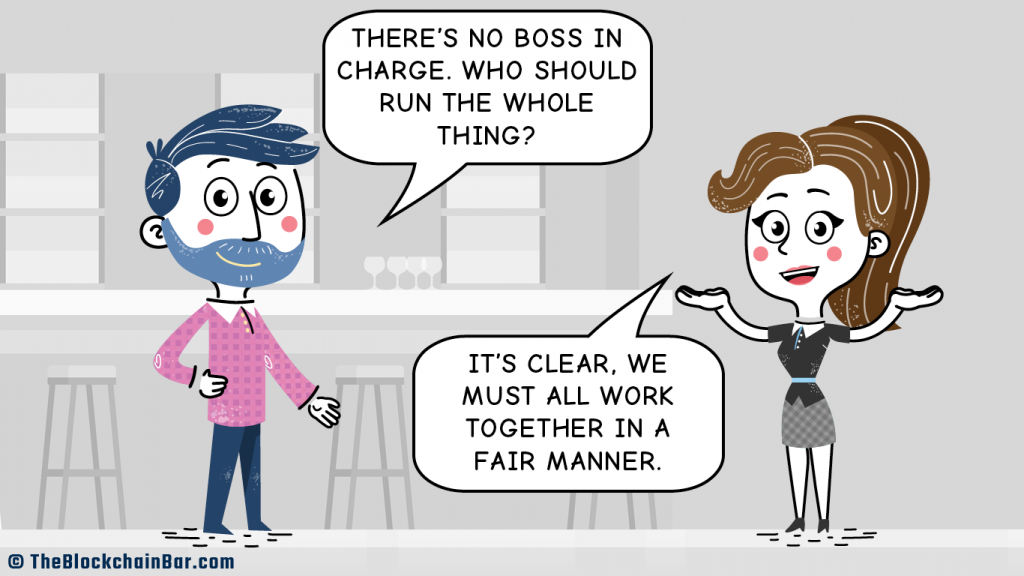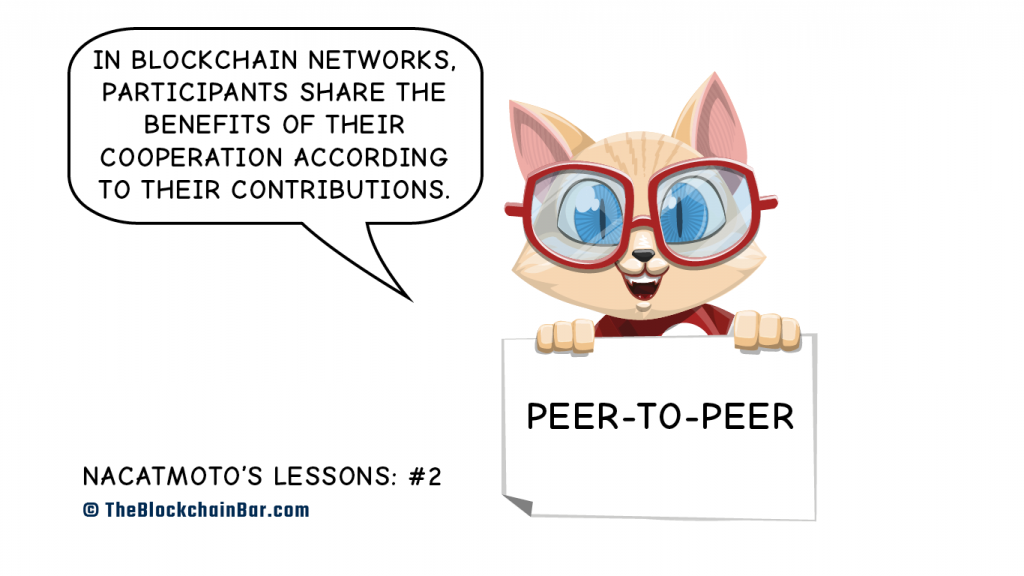Would you like to become the new bar owner? Or would you try to convince one of your friends to take on this task? Maybe there is a better alternative…
The bar owner is gone, and so is the cash register. There is no one in charge. But there are thirsty guests and many cold drinks. Oscar, a rather dubious guy, suggests: “Let’s all drink for free!” – “STOP!”, Carol screams. “Do you want to leave The Blockchain Bar in ruins? We need to find a way to keep this place we all love alive!”
“Carol is right!”, Bob says. “Who wants to run the bar?” – Hours later there is still no one willing to become the next bar owner. Alice has an idea: “Let’s manage the bar all together, as a cooperative.” – Everybody happily agrees.
A blockchain is a vast network of individual computers who all have the same rights and obligations. Such systems are also called peer-to-peer systems. All participants contribute to the network and work towards a common goal.
Working together? How can they avoid that everything ends up in chaos? Find out in our next episode …
But maybe you first want to read more about blockchain ‘cooperatives’ below.
Understanding Blockchain
Blockchain networks are peer-to-peer cooperatives
In many of today’s systems, there are middlemen who are in charge. Amazon is responsible for running its marketplace. The banks are responsible for smooth financial transactions on stable and secure networks. And the government collects money from its citizens and distributes it towards government services and common infrastructure.
Blockchain systems work without middlemen. Who is in charge, then? Who should run the network if there is no trusted authority? Who is responsible for operating The Blockchain Bar in our example when the bar owner is gone? How to share the burden, costs, and benefits of operating a platform, network, or bar in a fair manner?
The solution is obvious: all participants must keep the network or the bar running together. And everyone has to share costs and benefits fairly. This approach has existed for over 150 years: The participants should work together as a “cooperative”.
Here’s the Wikipedia definition: “A cooperative (also known as co-operative, co-op, or coop) is ‘an autonomous association of persons united voluntarily to meet their common economic, social, and cultural needs and aspirations through a jointly-owned and democratically-controlled enterprise’“
That is exactly what Bitcoin is supposed to be.
And that is the idea of blockchain networks in general: All nodes share the burden of operating the network and all can participate in the benefits generated by the network.
If done right, blockchain networks reward all members in relation to their contributions to the system. For example, in Bitcoin you can use the system and benefit from quick and cheap money transfers without being a ‘miner’. If you choose to be a miner, you help running the Bitcoin network by providing computer and network resources. Of course, miners get special rewards for keeping the system alive.
We’ll explain the concept of ‘miners’ in a later episode of Blockruption’s Blockchain Bar.
There are two basic types of how to allow new members into a blockchain ‘cooperative’:
- Permissioned blockchains: In permissioned blockchains some institution has to grant new members access to the network. For example, that institution could be a central governing body or a majority of the existing members have to vote.
- Permissionless blockchains: Bitcoin is the archetype of permissionless blockchains. Everyone can join the network as long as he/she runs the right software. There is no need to apply for ‘membership’. And there is no simple way of excluding anyone from the network.
Ethereum, the world’s second largest blockchain, is also permissionless.
Blockchains (‘cooperatives’) that aim at supporting the fundamental functions of human society should ultimately be or plan to become permissionless. For example, those areas where we need open, permissionless and inclusive systems are healthcare, energy, transport, political decision making, and, of course, beer supply.



